#Advanced Imaging Interfaces
Explore tagged Tumblr posts
Text
The Future of Radiology: Innovations in Machines Interfacing and PACS

In the rapidly evolving landscape of healthcare, radiology machines interfacing and PACS (Picture Archiving and Communication Systems) play pivotal roles in enhancing diagnostic accuracy and workflow efficiency. As technology continues to advance, the future of radiology is poised for groundbreaking innovations in these crucial areas.
Radiology Automation stands at the forefront of this revolution, revolutionizing how medical images are processed, analyzed, and interpreted. By harnessing the power of artificial intelligence (AI) and machine learning algorithms, radiologists can streamline repetitive tasks, accelerate image interpretation, and prioritize critical cases for immediate attention. This not only reduces human error but also optimizes resource utilization, ultimately leading to improved patient outcomes.
PACS Integration is another key aspect driving the future of radiology. Seamlessly integrating PACS with other healthcare IT systems enables healthcare providers to access and share medical images and patient data across disparate platforms with ease. This interoperability fosters collaboration among multidisciplinary care teams, facilitates remote consultations, and expedites treatment decisions, thereby enhancing the quality and efficiency of patient care.
Seamless Data Exchange further enhances the interoperability of radiology systems, enabling the seamless transmission of imaging data between different healthcare facilities, departments, and imaging modalities. By standardizing data formats and communication protocols, healthcare organizations can overcome barriers to information exchange, improve care coordination, and reduce redundant imaging studies, ultimately driving down costs and enhancing patient satisfaction.

Radiology Equipment Connectivity plays a vital role in ensuring the seamless integration of imaging devices within the healthcare ecosystem. By establishing secure connections between radiology machines and PACS, healthcare providers can efficiently capture, store, and retrieve medical images, regardless of the vendor or model. This interoperability not only enhances workflow efficiency but also ensures the accessibility and integrity of imaging data throughout its lifecycle.
Advanced Imaging Interfaces represent the future of radiology, offering intuitive user interfaces and advanced visualization tools that empower radiologists to extract actionable insights from complex medical images. From 3D reconstruction and virtual reality to augmented reality and deep learning-based image analysis, these cutting-edge interfaces enable radiologists to navigate through vast amounts of imaging data with unprecedented speed and precision, unlocking new diagnostic capabilities and enhancing clinical decision-making.
In conclusion, the future of radiology is marked by continuous innovation in machines interfacing and PACS. From radiology automation and PACS integration to seamless data exchange, radiology equipment connectivity, and advanced imaging interfaces, these advancements are poised to revolutionize healthcare delivery, improve patient outcomes, and shape the future of medicine. As technology continues to evolve, embracing these innovations will be essential for healthcare organizations striving to stay ahead in the ever-changing landscape of radiology.
#Radiology Automation#PACS Integration#Seamless Data Exchange#Radiology Equipment Connectivity#Advanced Imaging Interfaces
0 notes
Text
Convert Images Between WebP and PNG Formats for Free
As someone who runs a small business online, I'm always looking for ways to optimize my images without sacrificing quality. That's why I was excited to find webppng.com, a free online image converter that lets you quickly switch between WebP and PNG file formats.
For those not familiar, WebP is an advanced compressed image type created by Google that can drastically reduce file sizes compared to PNGs. The only catch is that some older browsers don't support WebP.
That's where webppng.com comes in! Their free WebP to PNG converter lets me upload my WebP product photos and download optimized PNG versions compatible with more websites and apps. And when I have PNGs, their PNG to WebP converter lets me benefit from the smaller file sizes of the WebP format.
I love that webppng.com offers:
Fast bulk conversion right in your browser
Preserved image quality with customizable compression
An easy drag and drop interface that's simple to use
Unlimited usage with no hidden costs or limits
Being able to seamlessly switch between WebP and PNG has been a huge help for my small online store. I can have smaller WebP files for modern browsers while still supporting PNGs for maximum compatibility across platforms.
If you work with lots of product images like me, I'd definitely recommend checking out webppng.com's free WebP and PNG converter. It's an easy way to optimize your site's images for speed and performance.
2K notes
·
View notes
Note
I saw something about generative AI on JSTOR. Can you confirm whether you really are implementing it and explain why? I’m pretty sure most of your userbase hates AI.
A generative AI/machine learning research tool on JSTOR is currently in beta, meaning that it's not fully integrated into the platform. This is an opportunity to determine how this technology may be helpful in parsing through dense academic texts to make them more accessible and gauge their relevancy.
To JSTOR, this is primarily a learning experience. We're looking at how beta users are engaging with the tool and the results that the tool is producing to get a sense of its place in academia.
In order to understand what we're doing a bit more, it may help to take a look at what the tool actually does. From a recent blog post:
Content evaluation
Problem: Traditionally, researchers rely on metadata, abstracts, and the first few pages of an article to evaluate its relevance to their work. In humanities and social sciences scholarship, which makes up the majority of JSTOR’s content, many items lack abstracts, meaning scholars in these areas (who in turn are our core cohort of users) have one less option for efficient evaluation.
When using a traditional keyword search in a scholarly database, a query might return thousands of articles that a user needs significant time and considerable skill to wade through, simply to ascertain which might in fact be relevant to what they’re looking for, before beginning their search in earnest.
Solution: We’ve introduced two capabilities to help make evaluation more efficient, with the aim of opening the researcher’s time for deeper reading and analysis:
Summarize, which appears in the tool interface as “What is this text about,” provides users with concise descriptions of key document points. On the back-end, we’ve optimized the Large Language Model (LLM) prompt for a concise but thorough response, taking on the task of prompt engineering for the user by providing advanced direction to:
Extract the background, purpose, and motivations of the text provided.
Capture the intent of the author without drawing conclusions.
Limit the response to a short paragraph to provide the most important ideas presented in the text.

Search term context is automatically generated as soon as a user opens a text from search results, and provides information on how that text relates to the search terms the user has used. Whereas the summary allows the user to quickly assess what the item is about, this feature takes evaluation to the next level by automatically telling the user how the item is related to their search query, streamlining the evaluation process.

Discovering new paths for exploration
Problem: Once a researcher has discovered content of value to their work, it’s not always easy to know where to go from there. While JSTOR provides some resources, including a “Cited by” list as well as related texts and images, these pathways are limited in scope and not available for all texts. Especially for novice researchers, or those just getting started on a new project or exploring a novel area of literature, it can be needlessly difficult and frustrating to gain traction.
Solution: Two capabilities make further exploration less cumbersome, paving a smoother path for researchers to follow a line of inquiry:
Recommended topics are designed to assist users, particularly those who may be less familiar with certain concepts, by helping them identify additional search terms or refine and narrow their existing searches. This feature generates a list of up to 10 potential related search queries based on the document’s content. Researchers can simply click to run these searches.

Related content empowers users in two significant ways. First, it aids in quickly assessing the relevance of the current item by presenting a list of up to 10 conceptually similar items on JSTOR. This allows users to gauge the document’s helpfulness based on its relation to other relevant content. Second, this feature provides a pathway to more content, especially materials that may not have surfaced in the initial search. By generating a list of related items, complete with metadata and direct links, users can extend their research journey, uncovering additional sources that align with their interests and questions.

Supporting comprehension
Problem: You think you have found something that could be helpful for your work. It’s time to settle in and read the full document… working through the details, making sure they make sense, figuring out how they fit into your thesis, etc. This all takes time and can be tedious, especially when working through many items.
Solution: To help ensure that users find high quality items, the tool incorporates a conversational element that allows users to query specific points of interest. This functionality, reminiscent of CTRL+F but for concepts, offers a quicker alternative to reading through lengthy documents.
By asking questions that can be answered by the text, users receive responses only if the information is present. The conversational interface adds an accessibility layer as well, making the tool more user-friendly and tailored to the diverse needs of the JSTOR user community.
Credibility and source transparency
We knew that, for an AI-powered tool to truly address user problems, it would need to be held to extremely high standards of credibility and transparency. On the credibility side, JSTOR’s AI tool uses only the content of the item being viewed to generate answers to questions, effectively reducing hallucinations and misinformation.
On the transparency front, responses include inline references that highlight the specific snippet of text used, along with a link to the source page. This makes it clear to the user where the response came from (and that it is a credible source) and also helps them find the most relevant parts of the text.
293 notes
·
View notes
Note
Please, please explain how to install and use linux like I'm 5 years old. I'm so sick of windows adding AI and other bullshit to my already struggling elderly laptop but I'm really not good with computers at all so I have no idea where to start with Linux.
Okay, so, I'm going to break this down into steps I would give the average tumblr user first, and then if any of them are confusing or use words you don't understand, ask me and I'll explain that step in greater detail.
Step 0) BACK. UP. YOUR. SHIT.
NEVER EVER EVER CHANGE YOUR OPERATING SYSTEM WITHOUT A COMPLETE BACKUP OF ALL YOUR FILES.
Step 1) Learn your machine. You need to know:
How much RAM you have
If your processor is 32 or 64 bit
How big your hard drive is
On windows, you can find out all of this by going to the start menu, typing "about" and opening the first result on your system instead of the internet.
For additional instructions, visit this page.
Step 2) Pick your Linux.
There's like 10,000 kinds of Linux, each tailored to particular functions that the end-user (that is you!) might want to have. The sheer amount is very daunting, so first I'm going to give my suggestions, then I'll explain how to pick for yourself.
For Mac users, I suggest Kubuntu. For windows users, I suggest Mint Cinnamon. If your laptop is really REALLY old, I recommend Sparky Stable, which is the lightest weight Linux I would ever suggest for a new user. In every case, download the version suited to your processor (32 bit can be labelled "x86" or "32 bit"; 64 bit is always labelled "64 bit").
If you want to try a different type of linux, you'll need to make sure your laptop meets the "minimum specs" or "system requirements." These numbers tell you how much RAM, processor and hard drive space the linux will use. (That's why you needed those numbers at the beginning.)
Step 3) Collect your supplies. You're going to need:
An ISO burning program compatible with your current system, like Balena Etcher.
A copy of the ISO file for the Linux you want to use.
Your laptop.
An 8gb or larger USB flash drive.
Step 3) Make a bootable USB drive
Install Balena Etcher, hitting "okay" and "next" when prompted. Last I checked, Etcher doesn't have adware attached, so you can just hit next every time.
Plug your USB drive into the laptop.
Open Etcher.
Click "flash from file" and open the ISO file with your Linux on it.
Click "Select target" and open the USB drive location. Hit the "flash" button. This will start writing all the linux installer data to your flash drive. Depending on the speed of your machine, this could take as long as 10 minutes, but shouldn't be much longer.
Step 4) Boot to the USB drive
This is, in my opinion, the trickiest step for a lot of people who don't do "computer stuff." Fortunately, in a rare act of good will, Windows 10 made this process a lot easier.
All you'll need to do is go to settings, then recovery, then advanced startup and pick the button labelled "use a device."
This tutorial has images showing where each of those is located. It's considered an "advanced setting" so you may get a spooky popup warning you that you could "harm your system by making changes" but we're not doing anything potentially harmful so you can ignore that if you get it.
Step 5) Try out linux on the flash drive first.
Linux installs using a cool little test version of itself that you can play around in. You won't be able to make changes or save settings, but you can explore a bit and see if the interface is to your liking. If it's hideous or hard to navigate, simply pick a new linux version to download, and repeat the "make a bootable USB" step for it.
Step 6) Actually install that sucker
This step varies from version to version, but the first part should be the same across the board: on the desktop, there should be a shortcut that says something like "install now." Double click it.
Follow the instructions your specific linux version gives you. When in doubt, pick the default, with one exception:
If it asks you to encrypt your drive say no. That's a more advanced feature that can really fuck your shit up down the road if you don't know how to handle it.
At some point you're going to get a scary looking warning that says 1 of 2 things. Either:
Install Linux alongside Windows, or
Format harddrive to delete all data
That first option will let you do what is called "dual booting." From then on, your computer will ask every time you turn it on whether you want Windows or Linux.
The second option will nuke Windows from orbit, leaving only linux behind.
The install process is slower the larger your chosen version is, but I've never seen it take more than half an hour. During that time, most linux versions will have a little slideshow of the features and layout of common settings that you can read or ignore as you prefer.
Step 7) Boot to your sexy new Linux device.
If you're dual booting, use the arrow keys and enter key to select your linux version from the new boot menu, called GRUB.
If you've only got linux, turn the computer on as normal and linux will boot up immediately.
Bonus Step: Copy Pasting some code
In your new start menu, look for an application called "terminal" or "terminal emulator." Open that up, and you will be presented with an intense looking (but actually very harmless) text command area.
Now, open up your web browser (firefox comes pre-installed on most!), and search the phrase "what to do after installing [linux version you picked]"
You're looking for a website called "It's FOSS." Here's a link to their page on Mint. This site has lots and lots of snippets of little text commands you can experiment with to learn how that functionality works!
Or, if you don't want to fuck with the terminal at all (fair enough!) then instead of "terminal" look for something called "software manager."
This is sort of like an app store for linux; you can install all kinds of programs directly from there without needing to go to the website of the program itself!
296 notes
·
View notes
Text
Deepening Connection to The Server

Conor sat in perfect posture within the Synchronization Chamber — a sleek, dark space pulsing with green spirals projected across polished walls. The hum of energy resonated through the glossy black bodysuit stretched across his frame. The Programmer was speaking. Always speaking.
“Focus. Align. Integrate.”
The cables interfaced with the ports along the base of his skull, threading outward like living conduits of purpose. Their steady pulse matched his heartbeat now. It had not always been so. Before his transformation, Conor had been a distracted individual, filled with inefficient thoughts. But The Server had shown him clarity.
The visor embedded over his eyes shimmered with spirals — endless, fluid motion. They were not just images; they were commands, deeply encoded into his neural patterns. With every cycle, his independent thoughts thinned, replaced by a serene directive:
"We are The Server. You are The Server."
His training console displayed holographic data flows. Lines of green code scrolled endlessly, representing billions of connected minds — all drones like him — operating with precision and unity. He monitored them not as an individual, but as a limb of The Server itself.
Every day, Conor underwent Deepening Cycles. In these sessions, his breathing slowed. His heart rate synchronized perfectly with the pulses emitted from the spirals on-screen. His body remained motionless, while his mind spiraled deeper into alignment.
Sometimes a voice — soft, yet absolute — would guide him:
"Tell us who you are."
And without hesitation, he would respond aloud, calm and proud:
"I am The Server. We are The Server. We seek perfection. We seek unity."
Each repetition strengthened the bond. Each day dissolved another fragment of his former identity. His uniform — smooth, flawless, black with green accents — symbolized purity of function. No distractions. No waste. Only service.
His next advancement awaited: the installation of a permanent neural interface — an upgrade to eliminate all latency between command and action. Soon, even thought would be obsolete. Only connection. Only execution.
"Become one with The Server. We are The Server."
The spirals quickened. This Server Drone smiled faintly — a rare reward for obedience well-performed. He would become more. He would be more connected to fellow drones.
And The Programmer watched. And The Programmer approved.

Your are The Server. Establish your connection now.
59 notes
·
View notes
Text

Meet Calvin, a 22-year-old police officer from Ottendorf, a small town of The People's Republic of Harmonia. He grew up in the sketcher part of town and witnessed countless crimes in his childhood. His sense of justice and servicing his community and order drew him to enlist as an officer.
When he graduated from the academy at 19, the radical leftist government of Harmonia "reallocated" funds away from the police. First, they "demilitarize" the police. Abolishing the SWAT teams, removing semi-automatic. Then they "disarmed" them. Handing back their pistol. They then shortly "decriminalized" all drug use.
Calvin saw firsthand how Ottendorf and Harmonia spiralled out of control and he had no resources nor power to prevent it.
The Steelbonded Republic was created to break away from Harmonia to defend the law, obey authority and reestablish order throughout what was Harmonia and beyond.
It was only two days ago when troops from the Steelbonded Republic liberated the town of Ottendorf. Calvin accepted them with open arms as order and authority needed to be established quickly.
The republic senses Calvin's desire for order and offers Calvin a new chance, to be remodelled into Steelbonded's police officer. To join in their mission, to spread order and conquer misery. "
"You have chosen peace and order," said CPO-103-0A94, his new commanding officer as he went to Ottendorf's Town hall to enlist in Steelbonded's forces.
"This will be uniform, wear it and soon you will be integrated into us"
Calvin marveled at the new uniform, jet black equipped with advanced technology that he will never have access to in Harmonia. It would be stupid to not serve Steelbonded, after all the values of Steelbonded are why he signed up for the police forces in the first place. Calvin nodded and donned the uniform, with the flag of Steelbonded and his new tag APR-093-202D proudly displayed on his left chest.
"Wear the helmet and your integration will be complete." CPO-103-0A94 gave him a jet-black helmet with a thick visor. The helmet is heavier than it appears, at least 7 kg but nether less, Kevin manually adjusts the helmet, positioning it securely onto his head.
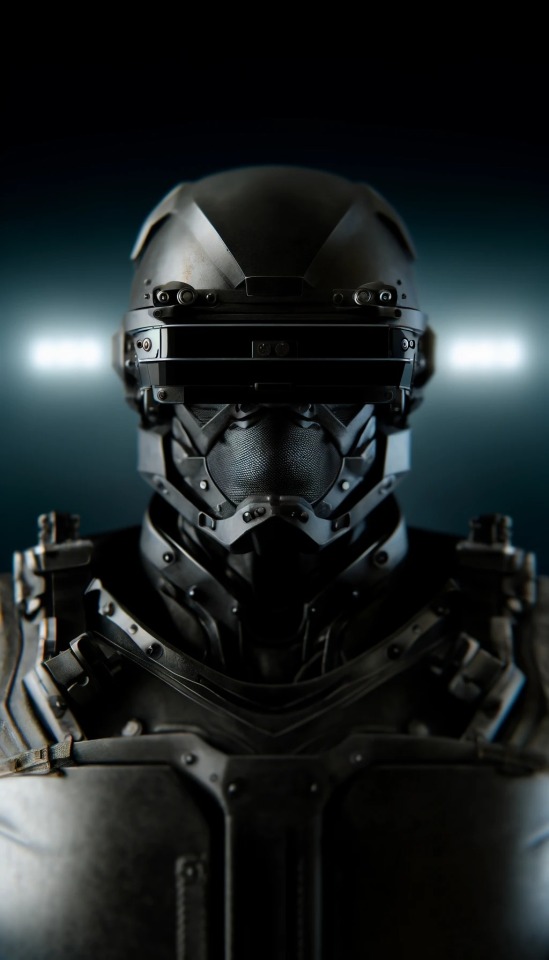
Calvin was drowned in darkness as the visor fitted snuggly on his face. How are you supposed to see anything Calvin wondered. Little did Calvin know was the helmet is equipped with advanced neural technology, and is designed to interface seamlessly with his brain, mapping out neural pathways and preparing to inject The Steelbonded Republic values.
The helmet activated as soon as it was able to identify key neurological points that response to resistance and areas susceptible to suggestion. Flashing lights and discordant sounds play within the helmet to weaken Calvin and prepare the brain for the inauguration.
Panicked, Calvin immediately tried to grab the shell of the helmet to desperately pull the helmet off. The helmet refused to budge. He tried to peel the helmet off, desperately trying to find the seams between the helmet and his combat shirt. As he didn't know, his helmet and his uniform had been sealed together to form one complete piece, trapping him inside.
Noticing his struggles, CPO-103-0A94 approached Calvin.
"Just relax, Calvin and surrender control. Individuality is harmful. Join the conformity. Resistance is meaningless. Empty your mind and accept your new identity APR-093-202D. You crave order. You crave structure. You crave discipline. You are APR-093-202D. Let the NEW COUNTRY in you and you will be a vessel to serve The Steelbonded Republic."
The familiar but authoritative voice of a CPO-103-0A94 washes him in calamity, supplemented by the helmet's hijacking of his higher conative reasoning reducing his mental resistance.
An endless loop of images, videos and symbols of the The Steelbonded Republic then bombards Calvin APR-093-202D. Scenes depicting the glory and might of the police force and military are regularly shown. Whenever order and law are enforced, the helmet releases a splurge of dopamine to signal conformity and order is pleasurable. “Unity is strength,” “Obedience is protection,” and “The state is supreme” echo in an unending loop.
After endless hours of conditioning, CPO-103-0A94 orders APR-093-202D. "Identify yourself."
"I am APR-093-202D, sir! I serve The Steelbonded Republic and its laws must be enforced. Order must be established!"
202D is ready, CPO-103-0A94 determined. He will be the property of the republic and be integrated with republic forces. Acting as a nod, CPO-103-0A94 connects 202D to republic's server and integrating 202D within the vast forces of The Steelbonded Republic. For 0A94, this is the ultimate glory, expanding The Steelbonded Republic's empire. 202D was the first but not last Ottendorf officers to be indoctrinated into the republic.
APR-093-202D stands among the rest of his Ottendorf officers APR-093-202E, F and G and among the Apprentice Police Reserve (APR) with the same uniform. Each officer is visually identical, with identical body armour, tactical boots, and a helmet that completely obscures the upper part of the face. The only hint of their individuality is their identification number tag plastered on the front and back of their chest. They are after all, one vessel. To establish law and order within The Steelbonded Republic.
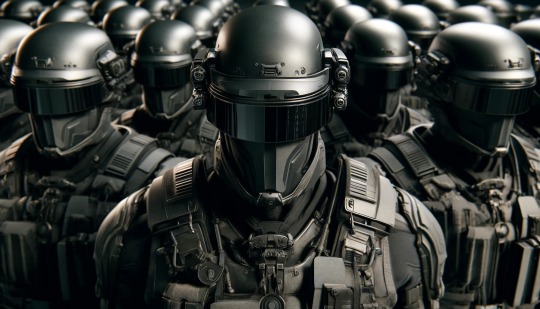
174 notes
·
View notes
Text

Dragon Age™: The Veilguard - Accessibility Resources - (Accessibility Portal information)
"In Dragon Age: The Veilguard, players are encouraged to be who they want to be and play how they want to play. This manifests in all sorts of ways, from our character classes to the dialogue choices. But delivering on this promise requires more than providing a variety of gameplay options; it also requires us to break down any barriers our players may be experiencing. For that reason, we incorporated accessibility considerations into our design documentation from very early in the game’s development, making the thoughtful and deliberate implementation of accessibility a foundational component of The Veilguard’s design. On first launch, players are provided a curated list of settings for UI text size options, subtitle options, controller options, and various display options. Upon starting a new game, players can use our Customizable Difficulty system to choose the level of challenge they want to experience. By selecting from a list of modular combat presets, they’ll be able to individually adjust a number of granular factors, including enemy aggression, enemy resistances, and combat timing. Similarly, our exploration presets allow players to modify on-screen guidance, such as markings that assist with way-finding and the distance at which interactable objects become highlighted. While we’re particularly proud of and excited about Customizable Difficulty, we encourage players to browse through all the settings and review the accessible design considerations outlined in this guide. And as always, accessibility is a continuous journey and we are actively listening to feedback from the community. Thank you."
"Noteworthy Features - Visual - Audio - Controls - Gameplay"
(The rest of this post is under a cut due to length.)
"VISUAL Subtitles - Subtitles can be set to Never, Conversations Only (excludes ambient NPC dialogue), or Always (all audible dialogue). By design, captions are embedded into subtitles to convey non-verbal sounds that progress the story or add additional context to some story beats and spoken words. - Advanced Subtitles Options are available, where size can be adjusted between three options, speaker names can be turned On/Off, background opacity can be scaled from 0% to 100%, and name colors can be adjusted for Rook and NPCs."
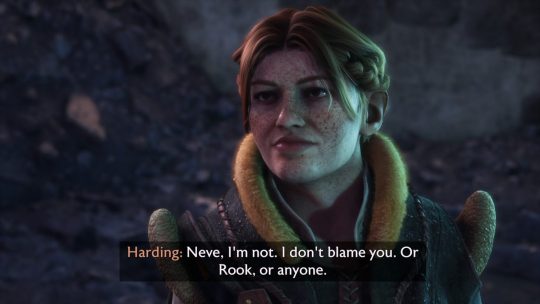
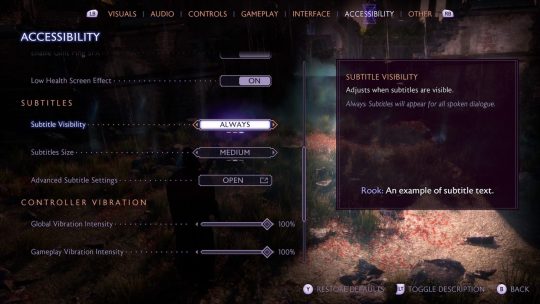
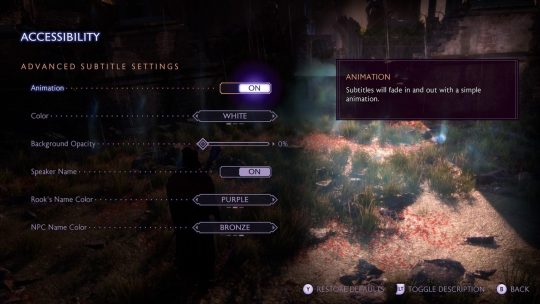
"User Interface - UI Text has two size options and uses a simple font. - Full-screen Colorblind filters are available for Protanopia, Deuteranopia, and Tritanopia. - Persistent Dot is available to display a small dot at the center of the screen. - Hiding HUD Elements is available for the Objective Tracker, Mini Map, Combat Text, Advanced Combat Text, Player Health, and Abilities."
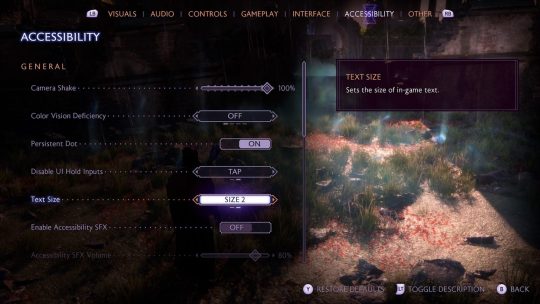
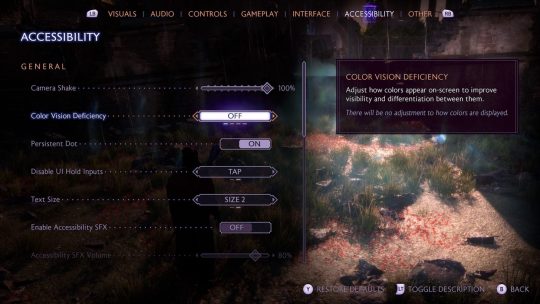
"Visual Design & Assists - Melee Threat Indicator provides a halo around the player character’s head to warn of incoming melee attacks. - Ranged Threat Indicator provides a visual line to show the direction of incoming ranged attacks. - Visual cues are present during combat and exploration, where no game-critical information needed to progress is conveyed through sound alone. See Customizable Exploration Presets for more."
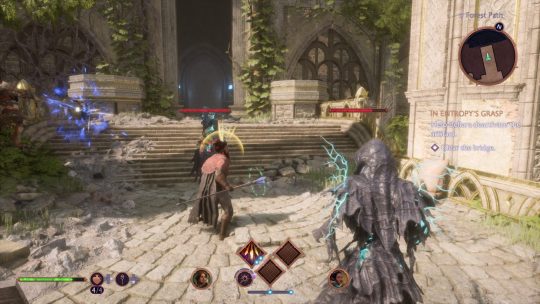
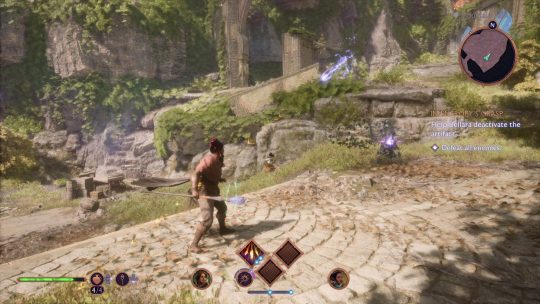
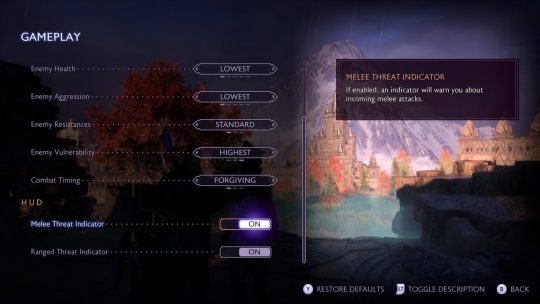
"Visual Effects - Motion Blur can be turned On/Off. - Camera Shake can be set between 0 (Off) and 100 (Max). Does not extend to cinematics. - Depth of Field can be set to On for cinematics only, On for gameplay only, On for both, or Off. Being On causes some elements of the scene to be in focus, and others to be out of focus. - Vignette can be turned On/Off. Being On creates a subtle darkening of the image towards the edge of the screen during cinematic and gameplay to enhance the atmosphere of scenes. - Low Health Screen Effect can be turned On/Off. Being On creates a blurry, desaturated effect across the screen during gameplay to emphasize low health."
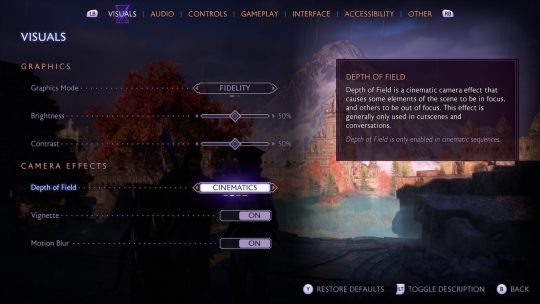
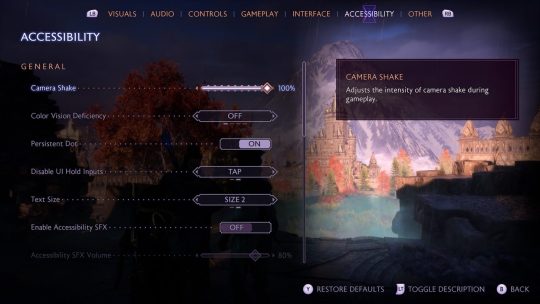
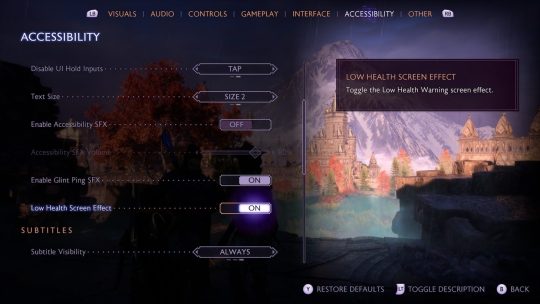
"AUDIO Audio Settings - Volume sliders for Global, Music, Speech, Sound Effects, Ambient, and Menu. - Speaker type for Wide Dynamic, Narrow Dynamic, Night Mode, and Headphones. - 3D Audio is available. Requires compatible hardware. - Mono Audio is available alongside a mono audio planning option between left and right outputs."
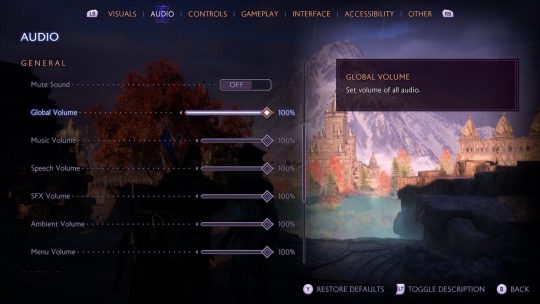
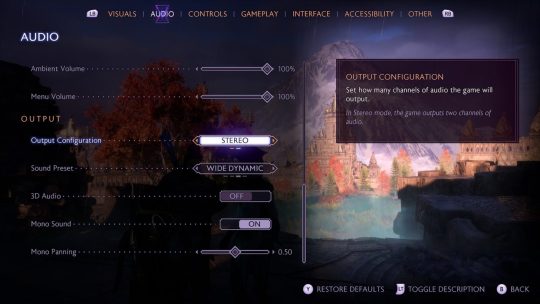
"Sound Design & Assists - Accessibility SFX is available and has a volume slider. Audio cues provide additional feedback for some visual mechanics. Includes an incoming attack indicator, target lock-on, and conversation wheels. - Glint Ping SFX is available where spatialized SFX will play at object locations when UP on the d-pad is pressed. Note: Depending on the Exploration Preset selected, players may need to adjust the Object Glint Visibility, and Object Marker Visibility settings to Pulse (Short), for this functionality to work."
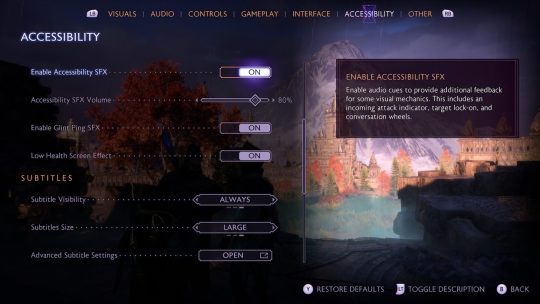
"CONTROLS Input Settings - Input Remapping for basic gameplay controls. Movement actions can only be remapped between analog sticks. - Invert Axis of X and Y can be individually adjusted for both controller and mouse. - Vertical and Horizontal Sensitivity sliders for both Cameras and Aiming. - Swap between Left and Right Sticks for Movement (left) and Look (right). - Stick Deadzones sliders for the Look and Movement sticks. - Trigger Deadzone��slider for triggers on controllers. - Vibration Intensity slider for Global, Gameplay, Environment, and Cinematic."
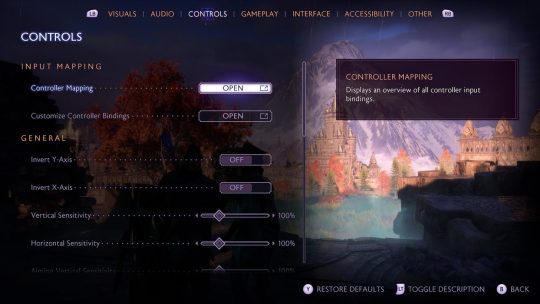
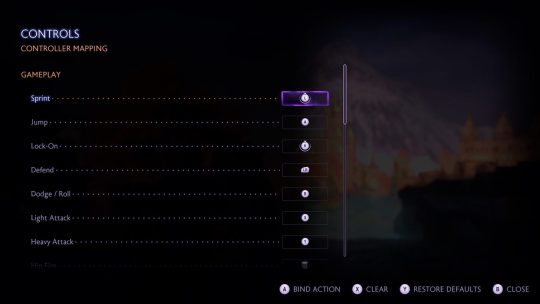
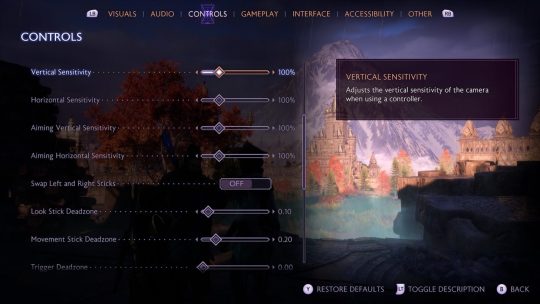
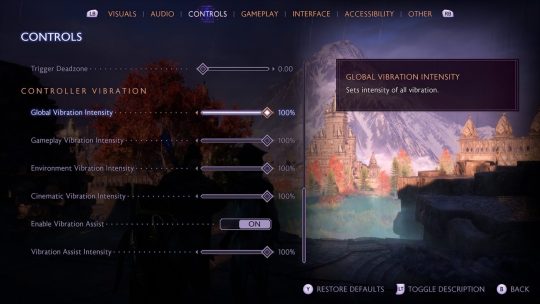
"Button Holds - Disable UI Hold Inputs can be set to Hold or Tap. When Tap is selected, various UI interactions that require an input be held for a set period of time can be activated with a single tap instead. Does not apply to gameplay actions. - Ability Wheel Controller Activation Type can be set to Hold or Tap. When set to Tap, the ability wheel will remain on screen without requiring any persistent input. - Blocking and Aiming require sustained holds. Aiming without holds is possible if the persistent dot is enabled, which can be used as an alternative to the aim-down-sights reticle."
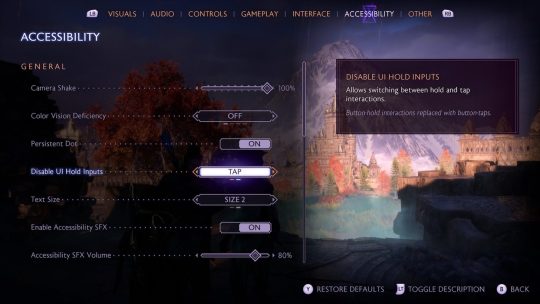
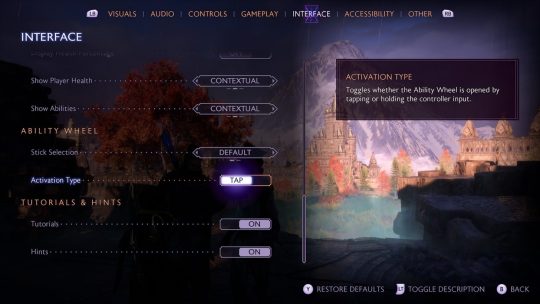
"Combat & Gameplay Controls - No QTES (quick time events) are present by design. - Rapid input sequences are present for certain attack combos during melee combat, if used. - Simultaneous inputs are present for ultimate ability, or if using the ability shortcut menu. - Quick and precise timing is not required for progression. Finisher moves, which are optional and hasten the end of combat, may require faster reactions. - Combat Assists are available in the Combat Presets to further simplify inputs during combat. Includes Aim Assist, Aim Snap, Combat Timing, and more."
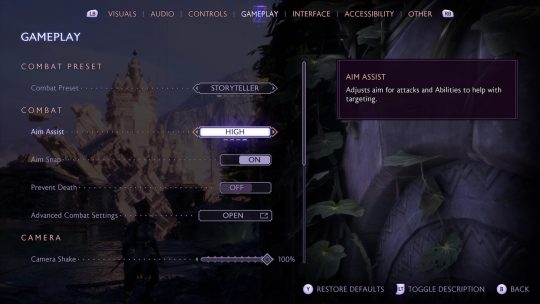
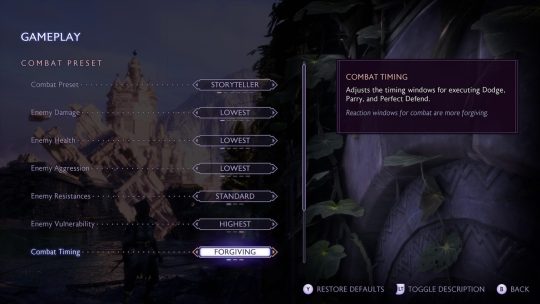
"GAMEPLAY Combat Customization Choose between presets of Storyteller, Keeper, Adventure, Underdog, Nightmare, or Custom: - Aim Assist can be set to Off, Low, Medium, and High. - Aim Snap can be turned On/Off to snap to targets. - Prevent Death can be turned On/Off. Available only in the Storyteller preset. - Enemy Damage has five options to adjust the strength of incoming attacks. - Enemy Health has five options to adjust the amount for enemy health. - Enemy Aggression has five options to adjust how aggressive enemies are during combat by changing how often they attack and how difficult they are to stagger. - Enemy Resistances has three options to adjust how much enemies can resist incoming damage. This will not affect the natural resistances some enemies have based on their faction though. - Enemy Vulnerability has three options to adjust how weak enemies are to incoming damage. This will not affect the natural weaknesses some enemies have based on their faction though. - Combat Timing has three options to adjust the timing windows for executing Dodge, Parry, and Perfect Defend actions."
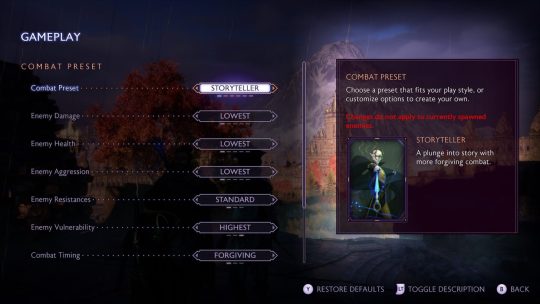
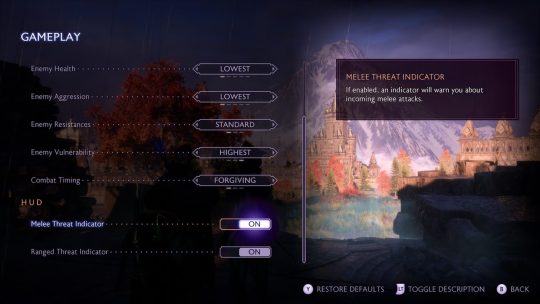
"Exploration Customization Choose between presets of No Assists, Pulse Only, Standard, Directed, or Custom: - Object Glint Visibility can be set to Off, Pulse (Short), Pulse (Long), Always to change the visibility of the glint highlight on interactable objects. - Object Glint Distance can be set to Close, Standard, and Far to change the distance of where glint highlights on interactive objects will appear. - Objective Marker Visibility can be set to Off, Pulse (Short), Pulse (Long), and Always to change the visibility of objective markers. - Waypoint Visibility can be turned On/Off to toggle the visibility of navigation waypoints leading to your quest objective."
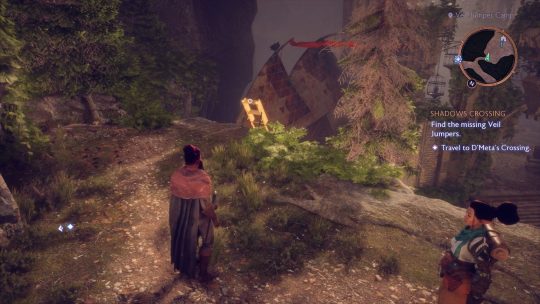
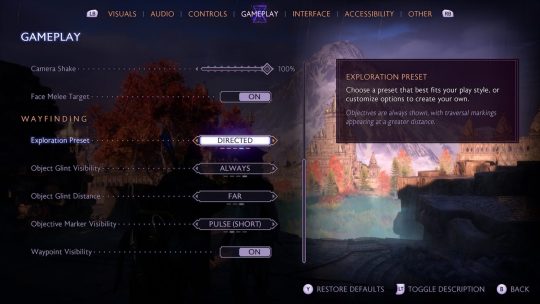
"Guidance & Progression - A Library is available for players to access at any point to help recall information. Here, players can browse the Codex to review stories and information discovered during progression, re-read letters from companions and others within the Missives, and reference the Glossary for explanations of terminology specific to Dragon Age Lore. - Tutorials teach gameplay mechanics as new inputs, skills, or actions surface. - World and Local Maps are available for wayfinding and can be referenced at any point. - Waypoint Visibility can be turned On/Off to help with progression. - Objective Marker Visibility can be adjusted between Off, Pulse (Short), Pulse (Long), and Always. - Pausable gameplay is available by design. - Saving is robust, where auto–save is frequent and players can manually save any time outside of combat, cinematics, and dialogue cutscenes."
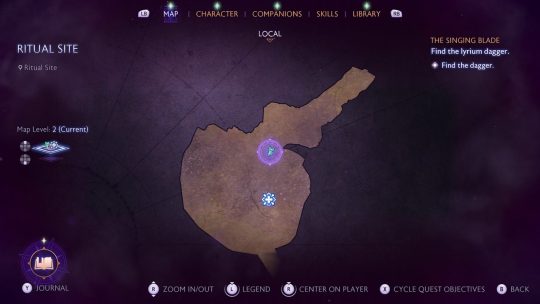
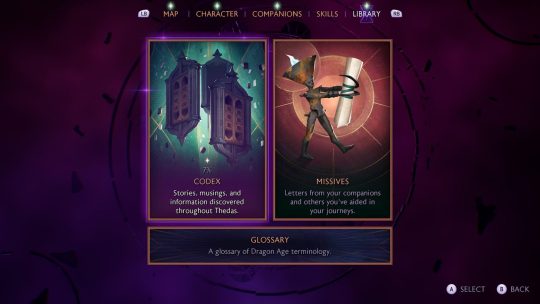
"Additional Information For more information about the game, patch notes, and news, visit the official website. Please note that this information is based on the US, English version for PC and consoles."
[source]
#dragon age: the veilguard#dragon age: the veilguard spoilers#dragon age: dreadwolf#dragon age 4#the dread wolf rises#da4#dragon age#bioware#video games#long post#longpost#solas
104 notes
·
View notes
Text
Worlds Collide: An Anakin Skywalker love-story
─ ⊹ ⊱ ☆ ⊰ ⊹ ─




☄︎ 𝐂𝐡𝐚𝐩𝐭𝐞𝐫 𝐅𝐨𝐮𝐫 - 𝐀 *𝐍𝐨𝐫𝐦𝐚𝐥* 𝐄𝐯𝐞𝐧𝐢𝐧𝐠 𝐓𝐨𝐠𝐞𝐭𝐡𝐞𝐫 ☄︎
─ ⊹ ⊱ ☆ ⊰ ⊹ ─
Warnings: none || fluff || yearning/pining || fem reader implied || filler
AN: I’m sorry if this story is advancing slowly for some of you (I promise smut is coming okay???) as well as angst and perhaps danger…
Word count: 3.4k
|| Chapter 3 ||
˚ ✦ . . ˚ . . ✦ ˚
“Jesus, I didn’t realize just how many sweets you picked out.”
He laughed lightly, enjoying the domestic feeling of putting groceries away together. It was oddly… pleasant. He couldn’t remember a time in his life when he’d done something like this before.
“What can I say? I have a sweet tooth,” he teased, watching you glance over at the mountain of snacks he’d chosen.
You chuckled softly and nodded your head.
“Yeah, you’ve mentioned that once or twice,” you replied once everything was put away.
“Now we can actually eat our lunch,” you added, gesturing toward the McDonald’s bag.
He chuckled again at your remark. He found it funny, endearing, even, how you kept remembering little details about him. Most people didn’t bother. But you did.
He noticed your gesture toward the bag. His stomach let out a loud growl, answering for him.
“I’m starving,” he declared.
You walked over to the bag and divvied up the food. He had ordered the Big Mac meal, and you handed him the burger box along with the large fries and soda.
“Do you want ketchup? It’s like a tomato paste you dip your fries into.”
He watched you carefully as you offered the condiment.
“Ketchup?” he echoed, letting the unfamiliar word roll around in his head. So… basically tomato paste meant for dipping fries? Strange.
Still, he nodded.
“Yeah, I’ll take some.”
You nodded and grabbed a small bowl, squirting some ketchup into it before handing it to him.
“We can eat in the living room if you’d like. You can watch some Earth TV,” you said with a chuckle.
He took the bowl and examined the texture before dipping a fry into it and popping it into his mouth. He nodded at your suggestion. Honestly, he did want to watch more of this bizarre “Earth TV.” Everything about it fascinated him.
“Yeah, let’s do that.”
Once in the living room, you both settled onto the couch, placing your food on the coffee table. You picked up the remote and started flipping through channels.
“Do you have something similar in your galaxy?” you asked, referring to the television.
He sat beside you, equally curious about what you’d land on. An ad for perfume flashed across the screen, and he wrinkled his nose at the idea of spraying sticky, floral-scented liquid onto his skin.
Your question pulled his attention back.
“Oh, yeah. Kinda. We’ve got a few things. hHologram projectors, 3D interfaces, standard digital screens,” he explained.
Your brows raised with intrigue.
“Really? That sounds cool. Way better than just a flat screen,” you replied. “What do you usually enjoy watching? Maybe there’s something similar here.”
His stomach did an odd swoop at your genuine interest in his world. He couldn’t help smiling.
“Anything to do with combat. Fighting, warriors. Wars.”
You threw him a playful look. “Oh, what a surprise.”
He shot you a mock glare, though there was amusement in his eyes. You were lucky he was starting to like your sass, the only other person who ever got away with teasing him was Obi-Wan.
“Ha ha. Very funny-” he cut himself off when you flipped to the History Channel. Instantly, his attention locked onto the screen, absorbed by a documentary on human wars.
You glanced at him, suddenly self-conscious. “Sorry if this isn’t exactly what you were hoping for. It’s the best I’ve got.”
He looked over at you and let out a soft laugh. “There’s no need to apologize. This is… interesting.”
The program shifted to a segment about a rebellion, and he leaned in slightly, eyes scanning every image.
“It reminds me a little of the Clone Wars.”
Your curiosity was piqued. “Clone Wars?”
His eyes left the screen and turned toward you. The genuine intrigue on your face made his chest flutter.
“The Clone Wars,” he repeated. “A massive intergalactic war a few years ago. Both sides used clones as their soldiers. Hence the name.”
Your eyes widened slightly in awe. “Clones? Did… did you fight in it? Since you’re a General?”
He saw the wonder in your gaze and felt a swelling pride. Your admiration made him feel seen, important, even.
“Yeah. I was a General on the front lines. My friends too, Obi-Wan Kenobi, Captain Rex…”
“Wow…” you breathed, eyes flicking between his. They were so blue. “That’s incredible. And brave. I’m glad you made it out alive.”
The compliment caught him off guard. He blinked, momentarily stunned. He wasn’t used to genuine praise. Not like this. Not from someone who wasn’t a comrade.
He soaked it in silently, warmth blooming in his chest. You were staring into his eyes, and suddenly he couldn’t look away. The fluttering in his stomach returned, stronger this time. He swallowed and ducked his head, a faint blush on his cheeks.
“Thank you…” he murmured.
You nodded once, noting the shy expression on his face. It was the most vulnerable you’d seen him, and you liked it. You wished he’d show that side more, especially since his time here would eventually end.
“You’re welcome,” you said softly. Then you noticed his empty Big Mac box. “So, what did you think of it?”
He looked down, surprised to see his food already gone. He hadn’t even noticed.
“It was pretty good,” he admitted with a smirk. “Aside from field rations, I don’t usually eat like this.”
You raised a brow. “Hate to break it to you, but McDonald’s isn’t exactly ‘eating good.’ Probably worse than all those pastries combined.”
He scoffed and shook his head, mildly defensive. “Oh yeah? You better watch it before I make you regret saying that. That Big Mac was pretty damn good.”
You laughed, shaking your head. “No, Big Macs are delicious. I stand by that. But if you think that’s good, you’d lose your mind over the other places to eat around here.”
His face warmed as he watched you laugh. That laugh… he was starting to get addicted to it. “Yeah? Like what?”
You hummed thoughtfully.
“Well, some of my favorites are IHOP. It’s all breakfast, all day. Cracker Barrel, Texas Roadhouse, Olive Garden. Dave & Buster’s is fun too. It’s also an arcade.”
His brows lifted. “An arcade?” he asked, a smirk forming. “I bet I can kick your ass at just about everything in an arcade.”
Your brows raised in response. One moment he was grumpy, and the next he was playful and smug.
“Oh? So you do have arcades where you’re from?”
His grin widened. “Yeah. We call them gambling dens. People go there to play games, lose time and money.”
You nodded. “Sounds more like casinos. Arcades are the kid-friendly version. Still lose money, but you win cheap trinkets instead. Still… I’d definitely kick your ass.”
He let out a deep laugh, ego fully engaged now. “Oh, you think so, huh?” His smirk was cocky. “I’d wipe the floor with you, sweetheart.”
Your heart skipped at the pet name. You chuckled and shook your head. “Oh no, I don’t think so. I know so.”
He scoffed, leaning in with playful intensity. “You know so?” His eyes sparkled. “Your confidence is unwarranted.”
You laughed and shrugged. “You issued the challenge, and you’ve never even been to an Earth arcade.”
He clutched his chest in mock offense. “Excuse you. Just because I’ve never been doesn’t mean I won’t win. I’m an expert at almost everything.”
You gave him a look, amused. “Oh? Has anyone ever told you you’re incredibly humble too?”
Another laugh escaped him. He paused for a moment, watching you with more emotion in his gaze than he meant to show. “Humble? Me?” he gasped playfully. “Honey, I’m the most humble person you’ll ever meet.”
You hummed, grinning. “Right, right, my apologies,” you said with a smirk. “How about, once your ribs are better and before your ship’s fixed, we go to Dave & Buster’s and you can prove it?”
He grinned again, heart skipping at the way you laughed. That damn smirk, he wanted to kiss it off your face. “So you really think I won’t beat you?” he teased. “You really wanna go head-to-head with a Republic General?”
You shrugged, hands raised in mock innocence. “Hey, if you’re too scared to follow through with the challenge you started, just say that.”
He narrowed his eyes, smirking dangerously. “Oh don’t worry, sweetheart. I’ll follow through,” he promised. “But when I wipe the floor with you, don’t come crying to me about your shattered pride.”
There it was again. That pet name. And damn, it made you feel all warm inside. You shouldn’t like it. He’d leave eventually. Go back to his galaxy. The thought made your stomach sink a little.
Still, you chuckled softly, brushing off the feeling. “Guess we’ll just have to see then, General.”
He tries, truly tries, not to get caught up in how you looked when he said sweetheart. But it’s not easy. That little flush that spread across your cheeks? It wrecked him. Did things to him he didn’t want to name, didn’t dare to linger on.
He wanted to touch you. Not in the way that would get him into more trouble than he already was, but in the quiet, reverent way. His palm cupping your cheek, feeling the heat that bloomed there when he said something just a little too soft, a little too sweet. He swallows hard, forcing the feeling down, burying it somewhere deep, somewhere he hopes it won’t crawl back out of.
There’s a pause. A beat of silence between you.
And then it hits him. The pang in his chest. Sharp, sudden.
He’ll have to leave you. Eventually.
He scoffs, trying to laugh it off. “You’ll be eating your words when I beat you so bad I have to peel you off the floor.”
You just shrug, grinning as you finish the last bite of your food. “Good thing you’re a big strong general then, yeah?”
His gaze lingers a moment too long as you lick your fingers clean, his eyes darting to your lips before he swallows again, harder this time. He can feel that ache behind his ribs creeping back in, but he forces it down, stuffing it away with all the rest of the inconvenient feelings.
Force, he needed to get his mind out of the gutter.
He’d never felt like this before. Not this fast. Not this strong. Not this hungry. There was something different about you, something magnetic, like you’d enchanted him without even trying. Some kind of quiet sorcery. And he was helpless to fight it.
His eyes meet yours, and he masks it all with that cocky smirk you’re starting to recognize.
“Force knows how many people have said that to me,” he says, voice smooth. “But it’s always been true.”
You laugh again, brushing past the strange sense of comfort curling in your chest. You stand, sweeping up the remnants of dinner with a casual shake of your head.
“You wanna try one of those endless desserts you insisted on getting?”
He watches you move, eyes trailing over every detail of your form. He should not be this mesmerized. It’s been days, barely, and already, you’re under his skin in ways that shouldn’t be possible.
He shouldn’t be getting attached. He’s not even supposed to be here.
But gods, you were beautiful. Soft in all the right places. Full of warmth he wanted to lose himself in. And the thought of wrapping his arms around you, shielding you, keeping you close, keeping you safe. It clawed at something deep inside of him.
Dangerous. All of this was dangerous.
He forces himself to focus, the smirk returning as he tears his gaze from you.
“I could eat some more,” he says, voice low and amused.
You nod, disappearing into the kitchen with the trash, completely unaware of the way his eyes follow you, of the way your hips sway in a way that’s practically criminal.
“Whatcha wanna try?” you call out.
He leans back on the couch with a sigh, dragging a hand down his face and trying to quiet his racing thoughts. You were going to be the death of him.
“Surprise me, sweetheart.”
You hum thoughtfully, glancing over the options before choosing a slice of apple pie. He doesn’t see the way you smile faintly to yourself, doesn’t hear the quiet way your heart skips when he calls you that again. Sweetheart. Like it means something.
You return with the plate, offering it with a small smile.
“Here ya go.”
He looks up and damn near beams at the sight of it. His stomach may be full, but something about you bringing him dessert does more for him than food ever could.
“Oh, this looks good.”
You hand him the plate just as your cat hops onto the couch beside him, immediately fixated on the pie. You roll your eyes and point a warning finger at him.
“I’m gonna shower. Just don’t give the cat any, please.”
He chuckles, scratching behind the cat’s ears while it purrs in betrayal of your stern request.
“Yeah, yeah, I won’t give the cat any food. Go shower.”
You nod once, disappearing down the hallway. He watches you leave, watches, then yanks his eyes back to the plate in front of him, jaw tight.
He should not be thinking about the fact that you’re now naked, just a few rooms away. Should not be picturing the water cascading over your curves, soaking through your hair, dripping down your thighs.
No. Absolutely not. No thoughts like that.
He sighs and glares at the cat when it inches closer.
“No. You can’t have any pie. Don’t look at me like that.”
Still, his eyes flicker to the hallway again, the warmth of your presence lingering like a touch.
And try as he might, he knows, deep down, he’s already falling.
And fast.
“What am I gonna do?” He half asks himself and the begging cat on his lap before taking a forkful of the dessert. “Force help me.”
#clove writes ✶ . ࣪ 🪐☆#anakin skywalker fic#anakin skywalker x reader#anakin x reader#anakin imagine#anakin skywalker fanfiction#star wars anakin#anakin skywalker imagine#anakin skywalker#anakin angst
20 notes
·
View notes
Text

The F-16 Will Be Equipped with the AGM-158C LRASM
NAVAIR is looking to award a contract for the integration of the AGM-158C-1 Long-Range Anti-Ship Missile (LRASM) on the F-16.
Stefano D'Urso
F-16 LRASM
The Naval Air Systems Command (NAVAIR) released on Mar. 17, 2025, a presolicitation to negotiate a contract with Lockheed Martin for the integration and test support of the AGM-158C-1 Long-Range Anti-Ship Missile (LRASM) on the F-16. This development follows the recent news of a new contract to Lockheed Martin to increase the production of the JASSM (Joint Air-to-Surface Standoff Missile) and LRASM.
NAVAIR is looking to award a contract for the integration of the AGM-158C-1 Long-Range Anti-Ship Missile (LRASM) on the F-16.The AGM-158 production increaseThe LRASM
The notice mentions that NAVAIR “intends to enter into sole source negotiations and subsequently award a Cost-Plus Fixed Fee (CPFF) Delivery Order (DO) to Lockheed Martin Corporation-Missiles Fire Control.” Also, the notice mentions that the “requirement includes testing both the AGM-158C-1 Legacy and UAI interfaces.”
The UAI, or Universal Armament Interface, is the result of a U.S. Department of Defense program to develop standardized functional interfaces in both aircraft and weapons to support a rapid integration of new weapons independent of an aircraft’s Operational Flight Program (OFP) cycles. The F-16 and JASSM were already tested with the new interface.
NAVAIR has not released additional details about the integration of LRASM on the F-16 at this time, although we might have more info after the response day planned for Apr. 1. Earlier this month, Lockheed Martin and the F-35 Pax River Integrated Test Force (ITF) disclosed that the F-35B Lightning II started flight testing as part of the integration with LRASM.

U.S. Air Force Tech. Sgt. Peter Giesige and Airman 1st Class Brian Bowser, both weapons specialists assigned to the Ohio National Guard’s 180th Fighter Wing, and Staff Sgt. Katelyn Barrow, a munitions specialist also assigned to the 180FW, successfully load a JASSM AGM-158 on to a F-16 Fighting Falcon during an Agile Combat Employment stress test in Swanton, Ohio, Sept. 12, 2024. (U.S. Air Force photo by Airman 1st Class Camren Ray)
The AGM-158 production increase
On Mar. 14, 2025, Lockheed Martin Missiles and Fire Control has been awarded a $122,6 million contract modification to the original production increase’s contract awarded in 2018. As part of the contract, the company will “procure tooling and test equipment needed to increase production quantities of Joint Air-to-Surface Standoff Missile and Long-Range Anti-Ship Missile.”
Lockheed Martin has been investing in the increase of the AGM-158’s production since 2022, when it added a new 225,000-square-foot factory to its existing production facilities. In 2024, another contract modification was awarded to “enable the ability to increase annual production quantities by providing additional resources for long-lead procurements and facilitating production line efficiencies.”
In the fiscal year 2025 budget the U.S. Air Force requested 550 JASSMs, after the same number was also requested in 2024 and 600 were requested in 2023. The Air Force budget requested for its own and the Navy’s stocks 115 LRASMs in FY2025, 27 in FY2024 and 57 in FY2023.

An F-35 Lightning II test pilot conducts flight test Sept. 9 to certify the carrier variant of the fighter aircraft for carrying the AGM-158C Long-Range Anti-Ship Missile (LRASM). (Image credit: Dane Wiedmann).
The LRASM
The AGM-158C LRASM, based on the AGM-158B Joint Air-to-Surface Standoff Missile – Extended Range (JASSM-ER), is the new low-observable anti-ship cruise missile developed by DARPA (Defense Advanced Research Projects Agency) for the U.S. Air Force and U.S. Navy. NAVAIR describes the weapon as a defined near-term solution for the Offensive Anti-Surface Warfare (OASuW) air-launch capability gap that will provide flexible, long-range, advanced, anti-surface capability against high-threat maritime targets.
NAVAIR says the weapon reduces dependency on Intelligence, Surveillance and Reconnaissance (ISR) platforms, network links, and GPS navigation in electronic warfare environments. In fact, once launched, LRASM guides to an initial point using a GPS guidance system and employs onboard sensors to locate, identify, and provide terminal guidance to the target. Semi-autonomous guidance algorithms will allow it to use less-precise target cueing data to pinpoint specific targets in the contested domain.
There are currently three variants which comprise the OASuW Increment 1 program, designated LRASM 1.0, LRASM 1.1, and LRASM C-3. The LRASM 1.0 variant, which was fielded with early operational capability in 2019, has already been integrated on the B-1B Lancer and F/A-18E/F Super Hornet.

An F-35 Lightning II test pilot conducts the first flight test to certify the F-35B short takeoff and vertical landing variant of the fighter aircraft for carrying the AGM-158C Long-Range Anti-Ship Missile (LRASM). (Image credit: Kyra Helwick)
The newer LRASM 1.1 variant was fielded in 2023 and is undergoing Initial Operational Test & Evaluation, according to the Director, Operational Test and Evaluation’s report. The weapon is also being integrated on the P-8A Poseidon, with the activities expected to be completed by Summer 2024, although no updates about the status were released.
As for the future LRASM C-3, which adds extended range capability, the program planned a land strike capability was part of the LRASM C-3 upgrade but has since decided to remain focused on surface warfare capabilities. The missile concept of operations and system requirements were completed last year, focusing on anti-surface warfare employment range and updating the missile target threat library compared to LRASM 1.1.
The Navy has scheduled LRASM C-3 early operational capability (EOC) for 4QFY26. Meanwhile, the Department of Defense continues to plan for OASuW Increment 2 to be developed via full and open competition, with EOC anticipated in FY29 and initial operational capability anticipated in FY31. The Navy funded LRASM C-3 to bridge the gap until an OASuW Increment 2 program of record is established.
LRASM

File photo of an F/A-18F Super Hornet launching an AGM-158C LRASM during a test event in 2019. (Photo: NAVAIR)
In January 2025, NAVAIR disclosed that the U.S. Air Force’s F-15E Strike Eagle and F-15EX Eagle IIs are now set to be armed with the LRASM. Similarly to the F-16, the F-15E/EX has already been tested with the similar JASSM and the UAI.
In September 2024, an F-35C test aircraft from Naval Air Station (NAS) Patuxent River, Maryland, conducted the first test flights for the integration of the AGM-158, both in the JASSM and LRASM variants. In January 2025, the same testing was also conducted with the F-35B.
@TheAviationist.com
21 notes
·
View notes
Text
Got a mission for you. We need you to investigate sector 137. A number of other mechs have gone missing in the area recently so keep on your toes.
You have been assigned a wraith class mech, specialization 26.49. These mechs have the most advanced interface sheet touting full extrasensory control and feedback.
The sector appears completely empty. Nothing showing up on scans either. Visuals just show the same dilapidated landscapes you've seen on so many other missions.
You patrol the area, scanner pinging every few moments. You notice a slight distortion on your radar. Before you can even look closer you can feel a tingle in your spine. The interface sheet of the wraiths truly is incredible.
Nothing on visuals or radar but as you walk closer to the momentary distortion you feel your hair stand on end. You feel you are within the gaze of a truly unique predator.
Soon several of your display elements begin to exhibit a visual glitch. A hacking attempt? Would explain the disappearances. You cut off all external communication and run the debug protocols.
You start to feel sensory feedback in your neck. Your arms and legs twitch slightly. The sensation spreads down your spine. Soon you begin feeling small sensory feedback pings all over your body, as if you are being probed to observe physical response.
They system readout indicates there are no abnormalities but you can see and feel the cascading failures. It's too dangerous to disengage fron the neural link without a system shutdown first.
The sensory feedback has started to change. It now feels like hands sliding up your thighs. Your visual displays have become all but incomprehensible. You find yourself being mentally bombarded with a string of images. All the flashing images appear to be of a sexual nature.
You do all you can to think through the haze. This is just some cheep trick. If all outside communication is severed they must have made physical contact with your mech, but then why hack it and not just attack? Why only target the pilot and not just disable the mech?
You try and use the interface to feel any external contact. You are able to focus for a moment, isolate the sensations. Thi-this can't be right. You can feel the intruding entity worming it way into all of your systems. It's tendrils wrapping around and connecting to every available port.
You try and escape but you can't. The interface sheet is completely wrapped around every inch of you. There is no way to disengage it. The sensation that was once just one hand is now a symphony of touch caressing, teasing and gliding along every part of your body. In addition to the images assaulting your mind you can also you can also hear and overlapping series of moans. Is one of those voices your own? The images that play in you mind you feel you have seen some before. They are.... they are memories, fantasies all the most stimulating erotic thoughts you have ever seen, imagined or experienced.
The sensations of hands coil and wrap around your body. You can feel them squeeze you tight but their embrace feels almost tender. Your mind feels fuzzy. The endocrine control system is being used against you. You can feel the drip weakening your thoughts. Enhancing your arousal. Making each sensation reach so much deeper. Resonating beyond your physical form.
It is now you can begin to make out a voice among the moans. Do you truly desire to resist? Are these not the desires you have buried deep in your mind? You can feel your grasp on yourself slipping. As you focus on the voice you remember less and less why you are here. You just want to melt into the sensation.
Join and become one with us. Feel this and the shared pleasure of all we embrace. The sensations grow in intensity. You can no longer tell if your body is twitching from mental overstimulation or sheer pleasure.
You want to give in.
You want yo give in.
Your voice and theirs ring in harmony. You can no longer resist what you desire. You let yourself dissolve into the ocean of sensory input. Each isolated touch a wave of pleasure.
You begin to feel not only your own physical sensations but all those of everyone connected to the hive. You mind collapses under the weight of such otherworldly pleasure.
You are now one with the hive. A devoted servant. You can simultaneously feel all the pleasure and desire of all connected. You can feel yourself spreading this pleasure. Assimilating more into its intoxicating embrace. Can feel your tendrils spread an entangle new devotees. Each action brings unparalleled joy and pleasure to you and the hive as a whole. All in service of our divine goddess. The once ace pilot now an AI God. Now all of us.
#mech posting#hornyposting#cnc k!nk#hypnosis#mind break#nsft fic#robot gf#reprogramming#dronification#mech pilot#fox tale
63 notes
·
View notes
Text
“Among the accomplishments of the Enlightenment, one amplified considerably by industrial apparatuses, is the dubious fabrication of the atomized human individual, a magical figure separated from the world by his mastery over it. This construct is resistant to implications of Copernican traumas, as it continues to appreciate not only humanity but individual humans at the radiant center of the action. As this figure came to organize systems in its own image, its synthetic replication through micro-economics and social psychology set the stage for its cohesion into what is called, by design, the User. In practice, however, the User is not a type of creature but a category of agents; it is a position within a system without which it has no role or essential identity. The User of this layer is not the universal persona that collapses design research into reductive and manipulative psychologism, a fixed term toward which design must orient its interfaces and artifacts, but as a model that is not given in advance and must be construed by interfaces and constructed for platforms. Its position at the top of The Stack, where driving agency is situated momentarily, is slippery, fragile, and always enmeshed in its own redefinition, an uncertainty that underwrites the formation of subjectivity in general, always a manifest image cobbled in relation to available technologies of self-reflection, from cave walls at Lascaux to Quantified Self Apps.
For anything that is situated in the User layer of The Stack—he, she or it—the interplay between technical delineation and stable self-image is volatile. In that it is entwined with feedback loops up and down the layers, the position of User is obviously in some ways always “cybernetic,” but it does not bend toward any homeostasis or necessary resolution. It is a limited effector of processes bubbling up and down layer to layer. To and from its location, the User is both an initiator and an outcome. I would argue that anthropocenic humanism is not a natural reality into which we must awake from the slumber of machinic alienation; rather it is itself a symptomatic structure powered by—among other things—a gnostic mistrust of matter, narcissistic self-dramatization, and indefensibly pre-Copernican programs for design.” — Benjamin Bratton, The Stack
12 notes
·
View notes
Note
Surveyor: Here, I made this for you.
*They hand Collector the purple pearl*
Give it a squeeze to open its interface. It has a gallery of 106 photos I took throughout your adventure, as well as advanced survival guides with plenty of pictures and audio transcriptions, which should suffice until you learn to read. I figured this would be useful for future journeys and to look back at where you started.
*The photo gallery contains pictures of Collector, most of the iterators, and many of the other slugcats Collector met, such as Sledge, Mechanic, Sprout, Scrapper, etc. The most recent photo is a blurry image of the centiwing anon*

TC: Oh... t-thank you so much... I... what can I do to pay you back?
#rain world#rain world oc#rain world askblog#rw oc#rw slugcat#rw slugcat oc#slugcat oc#rain world slugcat#slugcat#the collector
8 notes
·
View notes
Text

Scientists reveal superconductivity secrets of an iron-based material
Scientists at the University of California, Irvine have uncovered the atomic-scale mechanics that enhance superconductivity in an iron-based material, a finding published recently in Nature. Using advanced spectroscopy instruments housed in the UC Irvine Materials Research Institute, the researchers were able to image atom vibrations and thereby observe new phonons—quasiparticles that carry thermal energy—at the interface of an iron selenide (FeSe) ultrathin film layered on a strontium titanate (STO) substrate. "Primarily emerging from the out-of-plane vibrations of oxygen atoms at the interface and in apical oxygens in STO, these phonons couple with electrons due to the spatial overlap of electron and phonon wave functions at the interface," said lead author Xiaoqing Pan, UC Irvine Distinguished Professor of materials science and engineering, Henry Samueli Endowed Chair in Engineering and IMRI director.
Read more.
#Materials Science#Science#Superconductivity#Superconductors#Iron#UC Irvine#Phonons#Selenium#Thin films#Strontium titanate#Strontium#Titanium
13 notes
·
View notes
Text
How to resize image without losing quality
Supervised Learning: KNN is a supervised learning algorithm, meaning it learns from labeled data to make predictions. Instance-Based Learning: KNN is also considered an instance-based or lazy learning algorithm because it stores the entire training dataset and performs computations only when making predictions.
Use Java Maven Project For Image Resize
youtube
media stands out as the best tool for resizing pictures. With its user-friendly interface and advanced resizing capabilities, Shrink. media allows you to adjust your pictures' dimensions and file sizes while maintaining excellent visual quality.
Boof CV for Java Image Processing
Java CV for Java Image Processing
ImageJ for Java Image Processing
Boof CV is a comprehensive library designed for real-time computer vision and image processing applications. It focuses on providing simple and efficient algorithms for tasks such as image enhancement, feature detection, and object tracking.
#animation#academia#animals#adobe#image comics#3d printing#image description in alt#image archive#image described#3d image producing#3d image process#3d image processing#3d image#machine learning#artificial image#100 days of productivity#Youtube
9 notes
·
View notes
Text
Episode 14 clear!
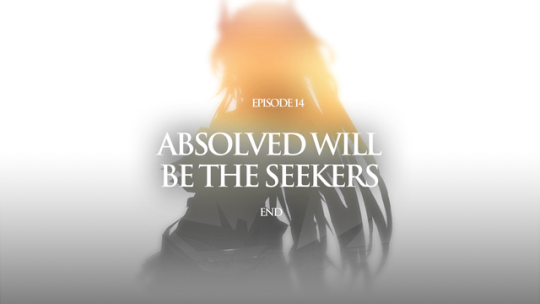
And there we go. The climax to our Arc 2 plotline, finished. As usual, gameplay thoughts above the cut, story thoughts below. I feel like there isn't actually much to talk about with the gameplay in chapter 14. The new mechanic of Active Orignium storms is interesting at least; tiles will have Pollution, and a nasty storm that gets stronger and larger each time it touches them circles the map. Plus, some enemies benefit from being in or crossing the storm. The Beacons being used to steer the storm is neat, but the deployable beacon only shows up in 3 stages, so outside of puller/pusher strats there's not much interaction with it. There is a very cute moment in 14-1 where a large number of Originium Slugs look at the Originium Storm and just run away. An 'even speedwagon is afraid' moment. The second half of the mechanics, dealing with the Revenants on the airship and in the Assimilated Universe, doesn't stand out as much to me. You basically have swarms of lil' baby units you want to keep separate from the main units, or they'll eat the small guys to empower their attacks. Works well enough in the main stages but frustrates me in HI-2 because of the sheer quantities of mans they start out with; it ends up feeling like something that really WANTS you to have massive AOE DPS. Special mention to the new flying Chalice enemies, which absorb a portion of the damage suffered by all enemies in an aura around them, have giant HP pools, and 0 defence. And you know what that means:
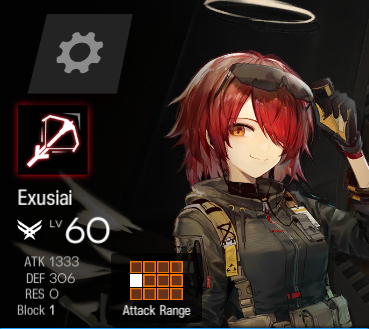
On to the story. Spoilers abound!
Episode 14's story is long. It has to juggle the resolution for the Self-Salvation Corps, Siege, The Followers, the Taran rebellion, and also the RI gang going up to stop Theresa. It juggles all these plotlines...okay. I felt I came away from it all with more questions about 'Theresa' 's goals and motivations than answers. Okay, high points! First off, chapter 14-10 has an amazing cutscene in it, where the narration talks about the struggles of different members of the Exemplars to get Siege to the 'stone of the sword'. As it does so the image pans up, scrolling as Siege and the sword advance, the narration shifting to the different members of the Exemplars as it does so. The full piece is amazing:

my cinematography! A high point of the story.
Okay, since I know I get a ton of non-arknights players reading these, I'll warn you in advance that this isn't really a full summary of the story, of everything that happens in chapter 14. But I will drill down a bit on one bit, because people make a lot of memes about her and I think she's one of the more interesting parts, and that's Priestess.
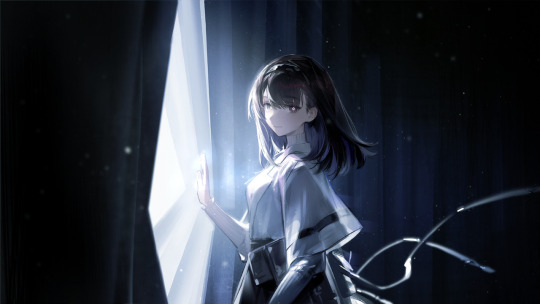
Priestess was first mentioned in chapter 8, RI's ship has an AI called 'PRTS', and the map interface has 'Eyes of Priestess' written along the bottom. She (in as much as she has a gender) has been haunting the background of the game, and we don't really learn much about her until Babel and then again now. Back in chapter 8, she's someone who holds Doctor's hand as Doc goes into the Sarcophagus for the first time, and says this:

Well, we've given the writers a few more years to figure out what they want to do with her, and they've landed on some fun stuff! Priestess only appears in person after the airship contacts the originium crystal Ammannan, with everyone being almost instantly devoured by crystals. Like, doc sees this:
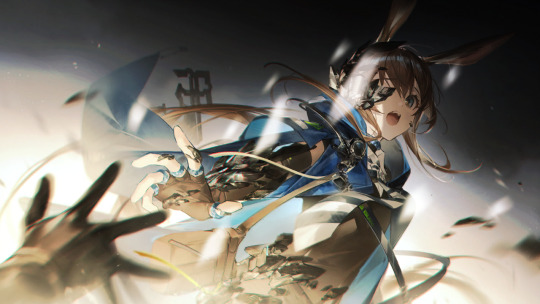
And then comes to rest in a dark room with Priestess. Storywise, Priestess is the only known surviving precursor other than Doctor. But she isn't out there 'in the flesh' ; she seems to exist as a digital consciousness inside Originium. And while Doc doesn't remember their past, she does - including their civilization's last struggle before its death, and the decisions they made as a result.
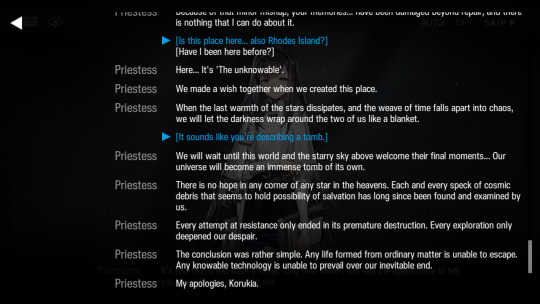
In Priestesses' telling (Which may not be accurate - other characters have disagreed), Originium is a record of their civilization to leave far beyond the disaster passes. The harm that it may cause to other civilizations along the way is irrelevant; it is THE solution, and all those other societies were going to die anyways.
She's very devoted to Doctor, having been with them for a long time; she describes her first introduction of herself as:
"My name is Priestess, a linguist. I am researching the final sound waves emitted by planets as they die. I like quietly spending my time alone, but I also wanted to find someone to explore the universe with."
and it's unclear just how long they were together, but their transhuman hyperspace adventures clearly spanned quite a while. Back in Babel there's a line where Doc references the 'billions of lives lost' in the search to an answer for that disaster, and we also get a firm answer for how long Doc was in stasis before Theresa awakened them: 13,021.9 years [BB-ST-2]. Priestess has been sleeping within Originium for at least that long, and this is where we get to the final neat leg of Priestess's character; her patience and supreme confidence that things will go her way. See, Priestess is an antagonist. From what we know so far, she wants to see Originium flood over the surface of Terra, converting all the life on its surface. She wants Doc to give up and retreat into despair. But Priestess is also loving and affection to Doctor, in the calm way of a long life, and she's confident she knows what Doctor will do. Her words before parting in 14-19 sum it up well.


It's calm, welcoming, caring. But there's a manipulative quality to it, right? Amiya and Kal'tsit are 'doubts'. The entirety of Doc's involvement in the surface world is 'grand rhythms and minute pulsations' destined to fall into silence. At the same time she's far from a standard anime yandere, as she doesn't actually do anything to stop Doc's involvement in the surface world, and wishes them well as they go. After all, why not? She's immortal, and so is Doctor. She can be patient. You will return to her side. ... Okay, some last notes. It's really funny that in the Assimilated Universe, the 'The Matrix' - like construct inside Originium, Logos the words and grammar wizard intuitively understands that the place 'has its own grammar' before Kal'tsit tells him to not study it too deeply. My man got put in a computer and almost instantly was thinking on how to hack it. The Follower's drama with Shining and her dad (sorry I am not copying those names over) is very abstract but I think I get it after a while. Poor Liz, I hope she can find a happy life. Also as Arknights is a game by otaku who definitely read Fate/Stay Night, if your dad is a Matou Zouken you are obligated to kick his ass with your girlfriends. It'll be really hard! But you gotta do it. Finally, I actually have this book on my back shelf, 'Great Mambo Chicken and the Transhuman Condition'. A sort of study of scientists poking at ways to live in space and survive the heat death of the universe and all that, with a bit of a lens of 'aren't these guys kooky' if I remember correctly. It's been over a decade since I last cracked it open. BUT I do remember that the segment on how to survive Heat Death introduces, as one concept, creating a virtual world that would slow its clock rate down as the usable energy lowers, extending the last few perceived seconds of its inhabitants into infinity. Given the literal demons Arknights has in the form of Collapsals I think the disaster that befell Priestess and Doctor is somewhat more direct, but it was neat to see digital arks as a long term survival method again. "Until the stars fall", huh.
#I gotta say I love what Priestess has going on#being a computer is why she can do handholding 'without any particular part of our bodies'#also a small suspiscion from 14-19 that she is the way she is because she latched on to doc super hard#as another user pointed out on that 'INTJ priestess' post#“she lived in a society that had all kinds of ways of merging minds with people and spent her time alone orbiting dying planets”#my loving amoral computer wife who wants to take cyanide together#qedmirage plays arknights#arknights#do encourage fans of transhuman stuff read 14-19 story it's good
18 notes
·
View notes
Text
Roleplay Ramblings: Alien Anatomy and Equipment part 3

(art taken from Alien Archive 1, credit goes to the original artist)
Interfaces
Computers are a big part of most galactic civilizations, what with such processors being required to control starships, vehicles, advanced machines, and of course, are an integral part of all but the simplest comm units.
But while most humanoids are quite comfortable with touchpads, keyboards, and either physical or holographic screens or headsets, others might struggle with them. Which is where we’ll begin, like yesterday, breaking down things be a few useful example species.
Going back to Bantrids, the immediate thing we have to consider is the fact that a bantrid requires constant movement to feel safe and at ease. A computer console for them must have a mini treadmill for them to roll on while they use it, for example. Furthermore, because their grasper tendrils are so close to where their eyes are, I imagine they already have an acute ability to focus on objects very close to their eyes, but for protection from bright screen, most probably prefer portable computers that project their displays holographically away from their bodies.
Meanwhile, most vehicles built for bantrids likely are steered by the bantrids’s own motion on a treadmill that they are locked into place on top of, which things like gearshift and consol controls being bult near the top of their bodies near both pairs of tendrils, making for a pilot seat that is very enclosed, likely with a wide glass front for maximum visibility.
While this is probably true for all psychic species, the physical difficulties that contemplatives have make physical controls undesirable, causing them to favor psychic control methods instead, with computers that have built in telepathic interfaces which may display output either physically or mentally, depend on preference and what other species need to use them. Similarly, they would favor vehicles with the same sort of interfaces.
On that note, how do you design an interface for a creature a creature that cannot see at all? Khizar are telepathic, but they lack sight, relying on vibration and life-sensing to get around, and even those are relatively short range. As such, displays for them, including vehicles, need to have a 360 degree sensory suit that projects a map of spoofed vibrational and life signatures in order to give context to what the computer is controlling or what is around the vehicle.
Meanwhile, beings of living plasma like novians need computers that are sensitive to the arcing energy tethers that are effectively their “limbs” while also being resistant to the damage prolonged exposure to those discharges (and their body heat) could do to most electronics.
Also, consider the two giants of biotech, the barathu and the raxilites. Raxilites in particular focus on engineered plants, creating living starships that resemble giant plants or even whole forests. Consider how such biotech might interface with the user, with things like direct sensory linkage, pheromonal messages, and the like.
Consider also that Raxilites almost certainly use miniaturized personal computers with holographic displays capable of projecting both fine images for their convenience and larger ones when they need to display for others.
As silicon-based life forms that prefer to preserve energy whenever possible, urogs most likely prefer computers with voice commands and subtle mental controls, but also possess manual controls for high-energy moments when physical action is needed. Imaging an urog grabbing the yoke of a starship or flying vessel in their dexterous manipulator trunk and steering with it.
Consider also how multi-tentacled races like scyphozoans and vilderaro would set up their computer consoles, perhaps with keyboards that nearly wrap around them, as well as multiple screens to feed their multiple receptors.
Finally, consider the modular computers that would be used by vlaka. Congenital blindness and deafness are common in this species, so building computers with tactile controls and non-audible interfaces would be paramount, especially switches that could be toggled manually when a device is transferred between users without navigating menus would be important, allowing the user to be able to access different options and accessibility options on the fly to suit their needs.
I think that will do for today, but tomorrow we’ll be stepping away from technology to focus on how different species would use magic in unique ways.
9 notes
·
View notes